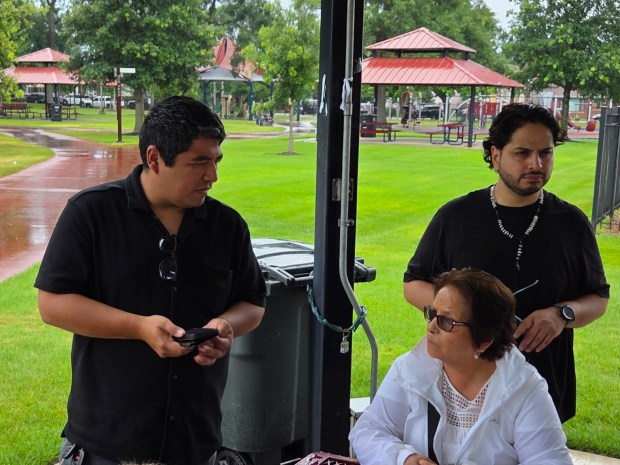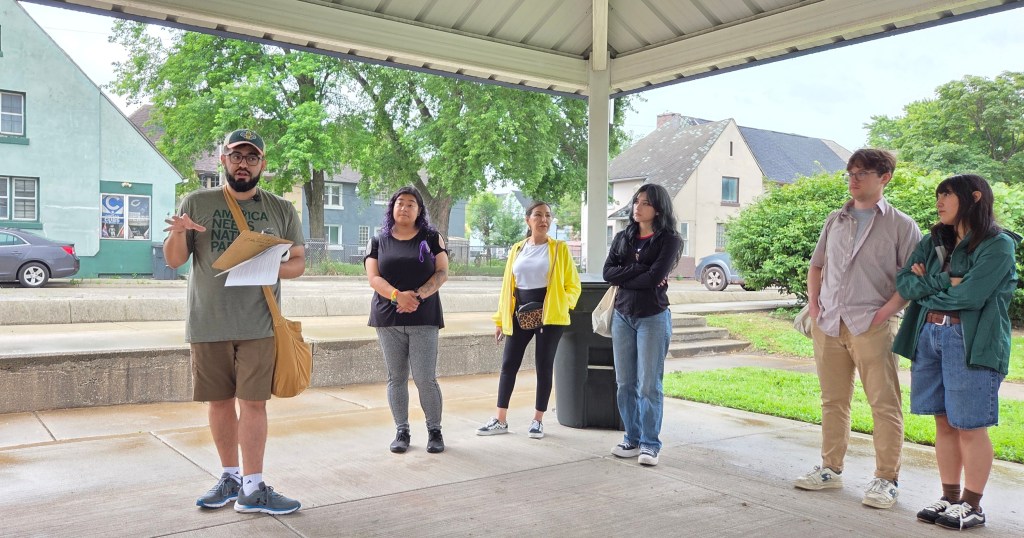When a municipality attempts to reindustrialize, especially without creating housing to accommodate it, it’s probably lost the plot for current and potential residents, if you ask Emiliano Aguilar.
No greater evidence of that is the former West Calumet Housing Complex in East Chicago, on which a spec warehouse now sits, Aguilar explained Saturday afternoon during the Industrial Heritage bus tour hosted by activist group Just Transition Northwest Indiana.
What once was home to some 1,000 residents before the city shut it down because of the catastrophic lead levels in the soil was rezoned as M-1 Light Industrial land in 2020, presumably to attempt to revitalize a city decimated by big industry’s continued contraction.
 Julio Ibarra, left, translates Notre Dame Professor Emiliano Aguilar’s talk for Alicia Mayo, center, while her son Salvador Mayo listens during the Just Transitions Northwest Indiana Industrial Heritage Bus tour Saturday, July 19, 2025. (Michelle L. Quinn/for Post-Tribune)
Julio Ibarra, left, translates Notre Dame Professor Emiliano Aguilar’s talk for Alicia Mayo, center, while her son Salvador Mayo listens during the Just Transitions Northwest Indiana Industrial Heritage Bus tour Saturday, July 19, 2025. (Michelle L. Quinn/for Post-Tribune)
The city in 2022 put up a spec warehouse on the old Edward Valve site on 143rd Street, where Midwest Historian and assistant History Professor for Notre Dame Aguilar’s grandfather worked, too. As of a few months ago, it was still advertising its availability.
“Reindustrialization is neglect,” Aguilar said to the 20 or so people who hopped on the bus. “East Chicago is zoned 75% industrial, but 19% residential and 5% for small businesses.”
East Chicago, and really the entire Calumet Region, became the place where Chicago shoved all its heavy industry in the mid-1800s while it rebranded itself into a place of leisure, with the Illinois Central, Michigan Southern and Northern Indiana Railroads setting down tracks in 1850. When the federal government switched the Grand Calumet’s flow from west to east in the 1870s, the Hammond Packing Company, which pioneered refrigeration, and myriad other heavy industries rapidly set down roots after that, Aguilar said.
But industry and its need for workers far outpaced residential building — Holy Trinity Croatian Church Rev. Clement Mlinanovich at one point pleaded with the Diocese of South Bend that he had a church, but his flock was living in tents around it – and attempts to rectify it were only so successful, Aguilar said. There was Marktown, the 190-acre industrial community with all early 20th century amenities designed by Chicago architecht Howard Van Doren Shaw at the behest of Howard Mark, but through a bunch of transactions that ended with the property getting sold to a real estate company that turned around and sold properties in it to individual landlords, it lost nearly all of its glory, he said.
Marktown residents endured racial criticism and staved off two more takeover attempts – when Youngstown Sheet and Tin tried to get the community rezoned for a tin mill in the 1950s and again when Indiana Gov. Edwin Whitcomb wanted to raze a third of the neighborhood for the Cline Avenue expansion – but the community, now a Historic Landmark but worse for the wear, faces a new enemy in BP, which has been buying up and razing properties from individual lanlords since 1998, Aguilar said. He doesn’t hold out much hope that Marktown will survive much longer.
“Kim Rodriguez, a third-generation resident of Marktown, has said, ‘The community has always stood strong and fought for what was good,’” Aguilar said. “But with reindustrialization, I can see Marktown ending up no more than two blocks when it’s all said and done. Look at what happened with the First National Bank building: It was a Historic Landmark, but Walgreens came in and demolished it anyway, and now the Walgreens is closed.
“While preservation looks nice, there’s no teeth to it.”
Any money the city received for “urban renewal,” such as the $20 million it received in 1959 for the Block and Pennsy project and the $13.4 million U.S. Housing and Urban Development gave it to build the housing complex at West Calumet in the 1970s, was largely given to friends of various mayors, who established “concrete barriers” within East Chicago, Aguilar said.
And with the Anaconda Copper Plant and U.S. Steel Lead Plant having been located on or near what became the West Calumet Housing Complex and former Carrie Gosch Elementary School, if the last five mayors didn’t know the extent of the contamination, they at least had to have had an idea it was there, he maintained.
Akeeshea Daniels, who became the face of the West Calumet Housing Complex when Mayor Anthony Copeland vacated it in 2016, would’ve attended the bus tour but sent her regrets with Lisa Vallee, organizing director with JTNWI. Going anywhere near that place triggers her deeply, Vallee said.
“She did everything she was supposed to do, and everyone still ignored her. If she weren’t a Black woman, it might’ve been different,” Vallee said of Daniels, whose family suffered lead poisoning. “In white communities, you have to disclose lead. No one cared here.”
Kieran Walsh, of Chicago, grew up in a small town outside Pittsburgh. East Chicago’s story resonated with him.
“It looks like where I’m from,” Walsh said. “It makes me think about the impact of industry and what happened in my town.”
“Greed is the same everywhere,” added Daniel Feldstin, also of Chicago.
Michelle L. Quinn is a freelance reporter for the Post-Tribune.
